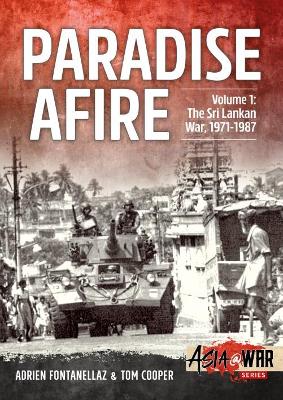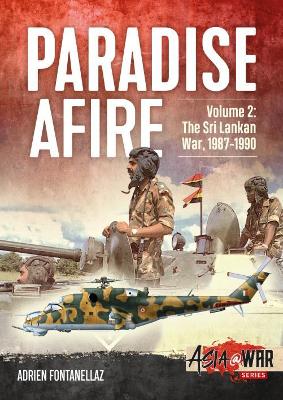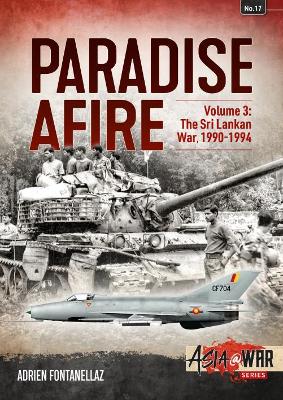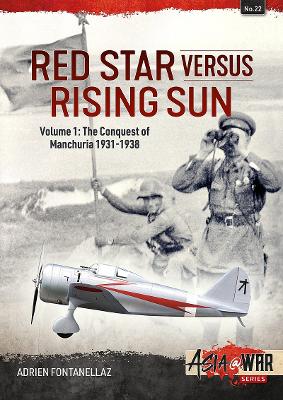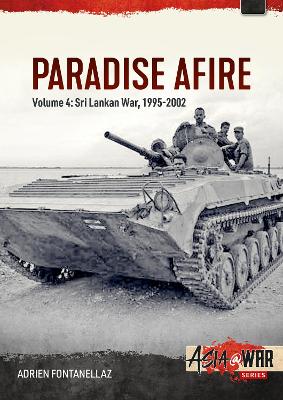Asia@War
5 total works
When released into independence from Great Britain, in 1948, the stunningly beautiful island of Ceylon, re-named Sri Lanka in 1972, was expected to become a sort of `South Asian Singapore'. However, stable political order and bright economic prospects proved insufficient to maintain peace. A host of unsolved ethnic conflicts and social inequalities conspired to erupt into an armed conflict, in 1971.
When this broke out the entire Sri Lankan society was shocked to its core by a large-scale insurgency instigated by a Sinhalese Maoist group, JVP. Worst still, this was followed by the gradual build-up of several other Tamil groups in the north of the island.
Following riots known as `Black July', in 1983, Sri Lanka was ripped apart by a murderous war against Tamil insurgents, which caught the armed forces wrong-footed because of the government's reluctance to build-up its military to necessary levels. This came to a temporary stop in 1987, with the implementation of a peace arrangement virtually enforced by the government of India and a deployment of a large peacekeeping force of the Indian military. By the time, the notorious LTTE emerged as the most powerful Tamil insurgent movement, and the principal opponent of the Sri Lankan armed forces.
Eventually, the Indian military intervention proved to be only a temporary solution. The LTTE turned against the Indian military but suffered heavily in return. However, this provided some breathing space for the Sri Lankan military, which then launched a vicious and protracted counterinsurgency campaign against the JVP. The fighting thus went on.
Relying on extensive studies of the Sri Lankan War with the help of first-hand sources, official documentation and publications from all of involved parties, this volume provides an in-depth and particularly detailed account of military operations during the first 16 years of this war.
When this broke out the entire Sri Lankan society was shocked to its core by a large-scale insurgency instigated by a Sinhalese Maoist group, JVP. Worst still, this was followed by the gradual build-up of several other Tamil groups in the north of the island.
Following riots known as `Black July', in 1983, Sri Lanka was ripped apart by a murderous war against Tamil insurgents, which caught the armed forces wrong-footed because of the government's reluctance to build-up its military to necessary levels. This came to a temporary stop in 1987, with the implementation of a peace arrangement virtually enforced by the government of India and a deployment of a large peacekeeping force of the Indian military. By the time, the notorious LTTE emerged as the most powerful Tamil insurgent movement, and the principal opponent of the Sri Lankan armed forces.
Eventually, the Indian military intervention proved to be only a temporary solution. The LTTE turned against the Indian military but suffered heavily in return. However, this provided some breathing space for the Sri Lankan military, which then launched a vicious and protracted counterinsurgency campaign against the JVP. The fighting thus went on.
Relying on extensive studies of the Sri Lankan War with the help of first-hand sources, official documentation and publications from all of involved parties, this volume provides an in-depth and particularly detailed account of military operations during the first 16 years of this war.
Upon achieving independence from Great Britain in 1948, the stunningly beautiful island of Ceylon, re-named Sri Lanka in 1972, was expected to become a sort of 'South Asian Singapore'. However, stable political order and bright economic prospects proved insufficient to maintain peace. A host of unsolved ethnic conflicts and social inequalities conspired to erupt into an armed conflict in 1971.
By 1987, the crisis heated up to the point where the government in New Delhi began exercising fierce pressure upon the Sri Lankan government and the Sri Lankan Tamil insurgents to arrive at a peace deal. In order to help maintain peace, the Indian Peace Keeping Force was deployed on the island.
However, with a few weeks, the troops of the Indian Army found themselves involved in a bloody and protracted confrontation with the most powerful of Tamil insurgent movements - the Liberation Tamil Tigers of Elam (LTTE). The peace-keeping operation was thus quickly converted into a military intervention and a bloody quagmire. To make matters even more complex, southern Sir Lanka meanwhile became engulfed in an unprecedented wave of public violence, triggered by the second insurrection of Sinhalese ultra-leftist movement, the JVP.
Calling upon extensive studies of the Sri Lankan War, with the help of first hand sources, official documentation and publications from all of the involved parties, this volume provides an in-depth and particularly detailed account of military operations between 1987 and 1990. It is illustrated by over 120 photographs, maps and 12 colour profiles.
By 1987, the crisis heated up to the point where the government in New Delhi began exercising fierce pressure upon the Sri Lankan government and the Sri Lankan Tamil insurgents to arrive at a peace deal. In order to help maintain peace, the Indian Peace Keeping Force was deployed on the island.
However, with a few weeks, the troops of the Indian Army found themselves involved in a bloody and protracted confrontation with the most powerful of Tamil insurgent movements - the Liberation Tamil Tigers of Elam (LTTE). The peace-keeping operation was thus quickly converted into a military intervention and a bloody quagmire. To make matters even more complex, southern Sir Lanka meanwhile became engulfed in an unprecedented wave of public violence, triggered by the second insurrection of Sinhalese ultra-leftist movement, the JVP.
Calling upon extensive studies of the Sri Lankan War, with the help of first hand sources, official documentation and publications from all of the involved parties, this volume provides an in-depth and particularly detailed account of military operations between 1987 and 1990. It is illustrated by over 120 photographs, maps and 12 colour profiles.
In June 1990, a mere three months after the Indian Peace Keeping Force withdrawal from Sri Lanka, the war between the Liberation Tigers of Tamil Eelam (LTTE) and the Sri Lankan government resumed and was to continue unabated until another cease-fire in early 1995.
This period of the protracted Sri Lankan civil war, known as Eelam War II, saw not only the LTTE evolve into a fully-fledged semi-conventional force, but also gained the reputation of being one of the most innovative and professional armed groups ever. This volume covers in detail the coming into being and the tactics of the Sea Tigers, the movement's naval wing infamous for its swarm tactics, but also the developments related to its intelligence wings and ground forces.
The Sri Lankan armed forces were however no underdog either. To the contrary, and despite numerous flaws that plagued their efforts, they were anything but passive, launching multiple offensives which were part of a cohesive and well thought-out strategy, all the while benefiting from the leadership of several extremely gifted officers, foremost Brig.Gen. Denzil Kobbekaduwa.
The two warring parties thus repeatedly fought each other in battles and campaigns of unheard off size and intensity so far, inflicting telling blows upon one another, but with both failing to gain the upper hand in the long run - until the two sides entered into a new round of negotiations which halted the conflict - for a mere few months.
Illustrated with over 100 photographs, maps and colour profiles, Paradise Afire Volume 3 continues the story of the internal strife that plagued Sri Lanka in the late 20th Century.
This period of the protracted Sri Lankan civil war, known as Eelam War II, saw not only the LTTE evolve into a fully-fledged semi-conventional force, but also gained the reputation of being one of the most innovative and professional armed groups ever. This volume covers in detail the coming into being and the tactics of the Sea Tigers, the movement's naval wing infamous for its swarm tactics, but also the developments related to its intelligence wings and ground forces.
The Sri Lankan armed forces were however no underdog either. To the contrary, and despite numerous flaws that plagued their efforts, they were anything but passive, launching multiple offensives which were part of a cohesive and well thought-out strategy, all the while benefiting from the leadership of several extremely gifted officers, foremost Brig.Gen. Denzil Kobbekaduwa.
The two warring parties thus repeatedly fought each other in battles and campaigns of unheard off size and intensity so far, inflicting telling blows upon one another, but with both failing to gain the upper hand in the long run - until the two sides entered into a new round of negotiations which halted the conflict - for a mere few months.
Illustrated with over 100 photographs, maps and colour profiles, Paradise Afire Volume 3 continues the story of the internal strife that plagued Sri Lanka in the late 20th Century.
Red Star Versus Rising Sun: Volume 1: The Conquest of Manchuria 1931-1938
by Adrien Fontanellaz
Published 1 April 2022
